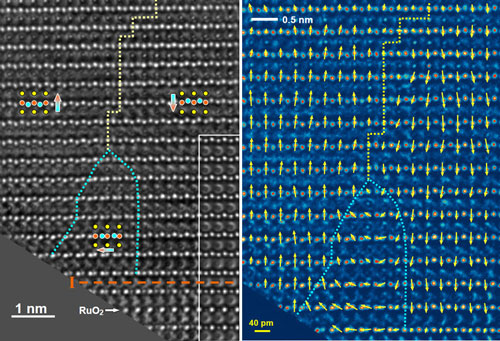| Mar 28, 2011 |
Data density in random access memory could be radically increased
|
|
(Nanowerk News) Scientists from the Forschungszentrum Jülich and the Max Planck Institute of Microstructure Physics in Halle have discovered the basis for the next generation of memory devices. In a ferroelectric material, they have, for the first time, been able to observe directly how dipoles, which store the information in this material, continuously rotate and therefore may be organised in circular structures.
|
|
The report was published in the journal Science ("Direct Observation of Continuous Electric Dipole Rotation in Flux-Closure Domains in Ferroelectric Pb(Zr,Ti)O3"). The findings were obtained using a type of high-resolution transmission electron microscopy with especially sharp contrast, developed by the Jülich scientists. Arranging the dipoles in a circular structure could allow for significantly denser data storage than previously possible, while still ensuring fast writing and reading processes.
|
 |
| Domains in a ferroelectric memory: The image from the aberration-corrected transmission electron microscope shows the positions of both the positively charged titanium and zirconium atoms and the negatively charged oxygen in a cross-section sample of the ferroelectric PZT. The extent to which the zirconium and titanium atoms have been displaced in the depolarised PZT (yellow arrows in the image on the right) indicates the orientation of the dipole moments. The yellow dotted line marks the boundary between the two domains with a polarisation which has rotated 180 degrees. The domain demarcated by the blue dotted line was observed for the first time. It represents a dipole flux closure. The red dashed line shows where the strontium ruthenate layer begins.
|
|
Ferroelectrics could be the way out of a dilemma troubling the chip industry. They provide durable storage and yet can be written and read quickly. Magnetic materials, on the other hand, which are used to produce hard disks and which provide permanent data storage, are sluggish. Semiconductors, for their part, are efficient in handling data, but quick to forget - which means that the electrical charges of their capacitors require constant renewal. Ferroelectrics combine the benefits of both materials. In addition, it may be possible to achieve greater data density in them than previously assumed. They could therefore soon become the material of choice for working memories with a density of several terabits per square inch.
|
|
Ferroelectric materials store bits in which their unit cells, their smallest structural units, are polarised. In other words, an electric field displaces the positively and negatively charged atoms slightly in relation to each other, so that the unit cells are somewhat distorted and a dipole is created. The dipole is maintained until a field of inverse polarisation switches the dipole or causes depolarisation. Each bit is assigned to an area – a so-called domain in physics – of the ferroelectric memory, where all the dipoles have the same orientation. "We have now discovered that under certain conditions the polarisation is maintained even in very small domains", says Chun-Lin Jia, a scientist at the Forschungszentrum Jülich.
|
|
The results were obtained through the use of a ferroelectric material produced at the Max Planck Institute of Microstructure Physics in Halle. The material, which goes by the designation of lead zirconate titanate (PZT), contains lead, zirconium, titanium and oxygen. Chun-Lin Jia and Knut Urban, Director of the Ernst Ruska Center for Microscopy and Spectroscopy with Electrons (based in Aachen and Jülich) have studied the sample of PZT using a particularly sensitive atomic-resolution transmission electron microscope. This aberration-corrected device delivers particularly sharp and contrast-rich images of very small details. It can even measure the positions of atoms with a precision of a few picometres (one picometre is a 10-12 metres). In contrast to conventional transmission electron microscopes, this method permits the localisation of the oxygen atoms in the PZT, where they are otherwise almost impossible to detect due to their weak scattering yield.
|

